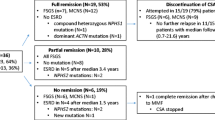Abstract
Background
High dose of cyclosporine (CyA) for ≥2 years in children with steroid-dependent nephrotic syndrome (SDNS) increases the risk for nephropathy. Considering this, risk can be lowered with lower doses of CyA; we evaluated the effects of a medium dose of CyA, with target serum level, C2, of 450 ng/ml, over a 2-year period of observation, to determine the need for follow-up kidney biopsy.
Methods
We retrospectively evaluated C2 levels in 38 patients (17 males, 5.2 ± 2.9 years old) with SDNS at treatment initiation, at 6, 12 and 18 months during treatment, and at the time of kidney biopsy, 2-year after treatment initiation. Fifteen patients were also treated with mizoribine or mycophenolate mofetil. A number of relapses-per-patient-per-year, relative to SDNS onset and initiation of CyA treatment, were evaluated. Serum levels of total protein, albumin and total cholesterol, blood urea nitrogen level, and the estimated glomerular filtration rate were measured at treatment initiation and at 1- and 2-year post-treatment initiation.
Results
Only one very mild case of CyA-associated nephrotoxicity was identified based on biopsy results at 2-year post-treatment initiation. C2 concentrations were maintained at 422.2 ± 133.5 ng/ml and the number of relapses decreased from 3.0 relapses-per-patient-per-year prior to CyA treatment to 0.47 relapses-per-patient-per-year after CyA treatment. No effects of the treatment on the estimated glomerular filtration rate were noted.
Conclusion
A 2-year treatment with a medium dose of cyclosporine A with or without other immunosuppressive agents is relatively safe with regard to the development of cyclosporine A nephrotoxicity.




Similar content being viewed by others
References
El-Husseini A, El-Basuony F, Mahmoud I, Sheashaa H, Sabry A, Hassan R, Taha N, Hassan N, Sayed-Ahmad N, Sobh M. Long-term effects of cyclosporine in children with idiopathic nephrotic syndrome: a single-centre experience. Nephrol Dial Transplant. 2005;20:2433–8.
Hodson EM, Willis NS, Craig JC. Non-corticosteroid treatment for nephrotic syndrome in children. Cochrane Database Syst Rev. 2008;23:CD002290.
Durkan AM, Hodson EM, Willis NS, Craig JC. Immunosuppressive agents in childhood nephrotic syndrome: a meta-analysis of randomized controlled trials. Kidney Int. 2001;59:1919–27.
Niaudet P, Reigneau O, Humbert H. A pharmacokinetic study of Neoral in childhood steroid-dependent nephrotic syndrome. Pediatr Nephrol. 2001;16:154–5.
Eddy AA, Symons JM. Nephrotic syndrome in childhood. Lancet. 2003;362:629–39.
Hibino S, Uemura O, Nagai T, Yamakawa S, Iwata N, Ito H, Nakano M, Tanaka K. Three year outcome of childhood idiopathic nephrotic syndrome under a unified immunosuppressive protocol. Pediatr Int. 2015;57:85–91.
Iijima K, Hamahira K, Tanaka R, Kobayashi A, Nozu K, Nakamura H, Yoshikawa N. Risk factors for cyclosporine-induced tubulointerstitial lesions in children with minimal change nephritic syndrome. Kidney Int. 2002;61:1801–5.
Mahalati K, Belitsky P, Sketris I, West K, Panek R. Neoral monitoring by simplified sparse sampling area under the concentration–time curve: its relationship to acute rejection and cyclosporine nephrotoxity early after kidney transplantation. Transplantation. 1999;68:55–62.
Clase CM, Mahalati K, Kiberd BA, Lawen JG, West KA, Fraser AD, Belitsky P. Adequate early cyclosporine exposure is critical to prevent renal allograft rejection: patients monitored by absorption profiling. Am J Transplant. 2002;2:789–95.
Fujinaga S, Kaneko K, Takada M, Ohtomo Y, Akashi S, Yamashiro Y. Preprandial C2 monitoring of cyclosporine treatment in children with nephrotic syndrome. Pediatr Nephrol. 2005;20:1359–60.
Nozu K, Iijima K, Sakaeda T, Okumura K, Nakanishi K, Yoshikawa N, Honda M, Ikeda M, Matsuo M. Cyclosporine A absorption profiles in children with nephrotic syndrome. Pediatr Nephrol. 2005;20:1660–3.
Ushijima K, Uemura O, Ymada T. Age effect on whole blood cyclosporine concentrations following oral administration in children with nephrotic syndrome. Eur J Pediatr. 2012;171:663–8.
Iijima K, Sako M, Oba MS, Ito S, Hataya H, Tanaka R, Ohwada Y, Kamei K, Ishikura K, Yata N, Nozu K, Honda M, Nakamura H, Nagata M, Ohashi Y, Nakanishi K, Yoshikawa N, Japanese Study Group of Kidney Disease in Children. Cyclosporine C2 monitoring for the treatment of frequently relapsing nephrotic syndrome in children: a multicenter randomized phase II trial. Clin J Am Soc Nephrol. 2014;9:271–8.
The primary nephrotic syndrome in children. Identification of patients with minimal change nephrotic syndrome from initial response to prednisone. A report of the International Study of Kidney Disease in Children. J Pediatr. 1981;98:561–4.
Uemura O, Nagai T, Ishikura K, Ito S, Hataya H, Gotoh Y, Fujita N, Akioka Y, Kaneko T, Honda M. Creatinine-based equation to estimate the glomerular filtration rate in Japanese children and adolescents with chronic kidney disease. Clin Exp Nephrol. 2014;18:626–33.
Uemura O, Nagai T, Ishikura K, Ito S, Hataya H, Gotoh Y, Fujita N, Akioka Y, Kaneko T, Honda M. Reference glomerular filtration rate levels in Japanese children: using the creatinine and cystatin C based estimated glomerular filtration rate. Clin Exp Nephrol. 2015;19:683–7.
Fujinaga S, Kaneko K, Muto T, Ohtomo Y, Murakami H, Yamashiro Y. Independent risk factors for chronic cyclosporine induced nephropathy in children with nephrotic syndrome. Arch Dis Child. 2006;91:666–70.
Kengne-Wafo S, Massella L, Diomedi-Camassei F, Gianviti A, Vivarelli M, Greco M, Stringini GR, Emma F. Risk factors for cyclosporine A nephrotoxicity in children with steroid-dependent nephrotic syndrome. Clin J Am Soc Nephrol. 2009;4:1409–16.
Author information
Authors and Affiliations
Corresponding author
Ethics declarations
Conflict of interest
The authors declare that no conflict of interest exists.
Research involving human participants
All procedures involving human participants were in accordance with the ethical standards of the institution at which the studies were conducted (IRB approval number #201611 at Aichi Children’s Health and Medical Center, #1118 at the Japanese Red Cross Nagoya Daini Hospital, and #2094 at Seirei Hamamatu General Hospital) and with standards of the 1964 Helsinki declaration and its later amendments or comparable ethical standards.
Informed consent
Due to the retrospective nature of our study, an opt-out for informed consent was granted.
About this article
Cite this article
Kuroyanagi, Y., Gotoh, Y., Kasahara, K. et al. Effectiveness and nephrotoxicity of a 2-year medium dose of cyclosporine in pediatric patients with steroid-dependent nephrotic syndrome: determination of the need for follow-up kidney biopsy. Clin Exp Nephrol 22, 413–419 (2018). https://doi.org/10.1007/s10157-017-1444-3
Received:
Accepted:
Published:
Issue Date:
DOI: https://doi.org/10.1007/s10157-017-1444-3




